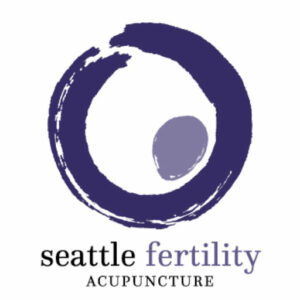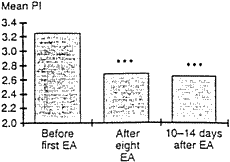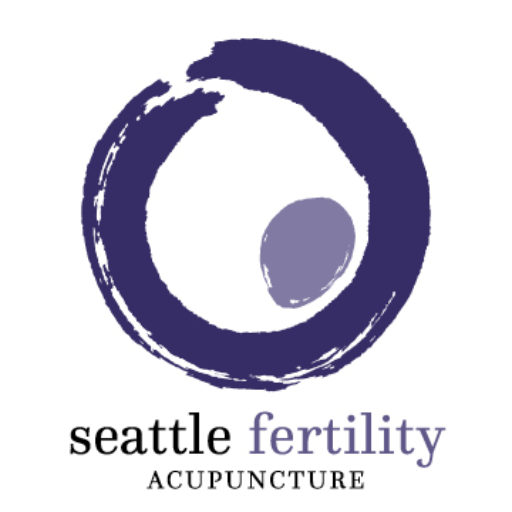Reduction of blood flow impedance in the uterine arteries of infertile women with electro-acupuncture
Elisabet Stener-Victorin[1.4], Urban Waldenström[2], Sven A. Andersson[3] and Matts Wikland[2] [1]Department of Obstetrics and Gynaecology [2]Fertility Centre Scandinavia. Department of Obstetrics and Gynaecology and [3]Department of Physiology University of Gothenburg. S-413 45 Gothenburg, Sweden [4]To whom correspondence should be addressed: Department of Obstetrics and Gynecology. Kvinnokliniken Sahlgrensh sjukhuset, S-413 45 Golhenburg, Sweden Source: European Society for Human Reproduction and Embryology
In order to assess whether electro-acupuncture (EA) can reduce a high uterine artery blood flow inpedance, 10 infertile but otherwise healthy women with a pulsatility index (PI) ≥3.0 in the uterine arteries were treated with EA in a prospective, non-randomized study. Before inclusion in the study and throughout the entire study period, the women were down-regulated with a gonadotrophin-releasing hormone analogue (GnRHa) in order to exclude any fluctuating endogenous hormone effects on the PI. The baseline PI was measured when the serum oestradiol was ≤0.1 nmol/l, and thereafter the women were given EA eight times, twice a week for 4 weeks. The PI was measured again closely after the eighth EA treatment, and once more 10-14 days after the EA period. Skin temperature on the forehead (STFH) and in the lumbosacral area (STLS) was measured during the flrst, fifth and eighth EA treatments. Compared to the mean baseline PI, the mean PI was significantly reduced both shortly after the eighth EA treatment (P < 0.0001) and 10-14 days after the EA period (P < 0.0001). STFH increased significantly during the EA treatments. It is suggested that both ot these effects are due to a central inhibition of the sympathetic activity. Key words: electro acupuncture/pulsatilily index (PI)/trans-vaginal colour Doppler curve/uterine artery blood flow
Introduction Successful in-vitro fertilization (IVF) and embryo transfer demand optimal endometrial receptivity at the time of implantation. Blood flow impedance in the uterine arteries, measured as the pulsatility index (PI) using transvaginal ultrasonography with pulsed Doppler curves, has been considered valuable in assessing endometrial receptivity (Goswamy and Steptoe, 1988; Sterzik et al., 1989; Steer et al., 1992, 1995a,b; Coulam et al., 1995; Tekay et al., 1995). Steer et al. (1992) found that a PI ≥3.0 at the time of embryo transfer could predict 35% of the failures to become pregnant. Coulam et al. (1995) did not observe any significant differences between PI measurements done on the day of oocyte retrieval compared with PI measurements on the day of embryo transfer. This would allow prediction of non-receptive endometria earlier in the cycle. Previous studies on rats have shown a decreased blood pressure after electro-acupuncture (EA) with low frequency (2 Hz) stimulation of muscle afferents (A-d fibres). The decreased blood pressure was related to reduced sympathetic activity (Yao et al., 1982; Hoffman and Thoren, 1986; Hoffman et al.. 1987, 1990a,b), and was paralleled by an increase in the ß-endorphin concentration in the cerebrospinal fluid (CSF), suggesting a causal relationship to central sympathetic inhibition (Cao et al., 1983; Moriyama 1987; Reid and Rubin, 1987). The cardiovascular effects of acupuncture treatment are probably mediated by central opioid activity via the ß-endorphin system from the hypothalamus. The aim of this study was to evaluate whether EA can reduce a high impedance in the uterine arteries. There are several conceivable mechanisms which may give this effect. In addition to central sympathetic inhibition via the endorphin system, vasodilatation may be caused by stimulation of sensory nerve fibres which inhibit the sympathetic outflow at the spinal level, or by antidromic nerve impulses which release substance-P and calcitonin gene-related peptide from peripheral nerve terminals (Jansen et al., 1989; Andersson, 1993; Andersson and Lundeberg, 1995). It has been assumed that various disorders in the autonomic nervous system, such as hormonal disturbances, may be normalized during auricular acupuncture (Gerhard and Postneck, 1992). It has also been suggested that the concentrations of central opioids may regulate the function of the hypothalamic-pituitary-ovarian axis via the central sympathetic system, and that a hyperactive sympathetic system in anovulatory patients could be normalized by EA (Chen and Yin, 1991).
Materials and Methods
Subjects, design and Pl measurements The study was approved by the ethics committee of the University of Gothenburg and was conducted at the Fertility Centre Scandinavia, Gothenburg, Sweden, a tertiary private IVF unit. All women attending the clinic for information about the IVF/embryo transfer procedure, had the PI of their uterine arteries measured by transvaginal ultrasonography and pulsed Doppler curves (Aloka SSD 680: Berner Medecinteknik, Stockholm, Sweden). The PI value for each artery was calculated electronically from a smooth curve fitted to the average waveform over three cardiac cycles, according to the formula: Pl = (A – B)/mean, where A is the peak systolic Doppler shift, B is the end diastolic shift frequency and mean is the mean maximum Doppler shifted frequency over the cardiac cycle. A reduction in the value of PI is thought to indicate a reduction in impedance distal to the point of sampling (Steer et al., 1990). In the routine preparation for their IVF/embryo transfer treatment, all women were down-regulated with a gonadotrophin-releasing hormone analogue (GnRHa) (Suprecur: Hoechst. Germany). When their oestradiol concentration in serum was <0.1 nmol/1, the women were considered down-regulated and the PI of their uterine arteries was again measured in those women showing a mean Pl ≥3.0 before down-regulation. The measurements were done by two of the authors (M.W. and U.W.) between 08.30 h and 14.30 h. These hours were chosen for practical reasons, and also to reduce the risk that the PI measurements would be affected by the circadian rhythm in blood flow, recently reported by Zaidi et al. (1995). Three measurements were made on the right and three on the left uterine artery of each patient. Before the study was conducted, the observers were well trained in PI measurements with the equipment used. Steer et al. (1995) has shown that in trained hands, the inter-, and intra-observer variations in vaginal colour Doppler ultrasound are sufficiently small to provide a basis for clinically reliable work. PI measurements were done on all women attending the unit for an IVF/embryo transfer treatment between November 1992 and February 1993. Of these, all infertile but otherwise healthy women, with a mean PI ≥3.0 in the uterine arteries both before and after down-regulation, were invited to be included in the study. In all, 10 women accepted after informed consent and they had a mean age of 32.3 years (range 25-40 years). The infertility diagnoses were unexplained infertility (n = 6), tubal factor (n = 3) and polycystic ovarian syndrome (n = 1). From their inclusion and onwards, the women were kept on the GnRHa and were given no other pharmacological treatment. Consequently, their gonadotrophins and ovarian steroids were kept at a constantly low concentration, both at their inclusion in the study and throughout the whole study period. Thus, PI changes due to hormonal fluctuations were avoided. EA was then given eight times, twice a week for 4 weeks. The mean PI of the uterine arteries was measured (mean of three PI on each side) directly after the eighth EA treatment and again 10-14 days after the EA period. Of the 10 women included, two were later excluded. One of them, with tubal factor infertility, was excluded because she started taking medications for her migraine, which could have affected her PI. The other excluded woman, with unexplained infertility, stopped her GnRHa treatment because she preferred IVF/embryo transfer in a natural cycle.
Acupuncture Treatment The sympathetic outflow may be inhibited at the segmental level and, for this reason, acupuncture points were selected in somatic segments according to the innervation of the uterus (Thl2-L2, S2-S3) (Bonica, 1990). The needles were inserted i.m. to a depth of 10-20 mm. The aim of the stimulation was to activate group III muscle-nerve afferents. The needles were twirled to evoke `needle sensation,’ often described as tension, numbness, tingling and soreness, sometimes radiating from the point of insertion. The needles were then attached to an electrical stimulator (WQ-6F: Wilkris & Co. AB, Stockholm, Sweden) for 30 min. The location of the needles was the same in all women (Table I). Table 1. Acupuncture points, their anatomical position and their innervation
| Points* | Segmental innervation (afferent muscle) | Muscle localization |
| BL 23 | L1, 2, 3 | Erector spinae thoracolumbale |
| BL 28 | L4, 5, S1, 2, 3 | Erector spinae lumbosacrale |
| SP 6 | L4, 5, S2, 3 | Tibialis posterior at the medial side |
| BL 57 | S1, 2 | Gastrocnemius and m. soleus at the dorsal side |
*All were placed bilaterally. BL – bladder channel. SP – spleen channel. Four needles were located bilaterally at the thoracolumbar and lumbosacral levels of the erector spinae, and were stimulated with high frequency (100 Hz) pulses of 0.5 ms duration. The intensity was low, giving non-painful paraesthesia. Four needles were located bilaterally in the calf muscles, and were stimulated with low frequency (2 Hz) pulses of 0.5 ms duration. The intensity was sufficient to cause local muscle contractions.
Skin temperature The skin temperature was measured with a digital infrared thermometer (Microscanner D-series: Exergen, Watertown, MA, USA) between the applied acupuncture needles in the lumbosacral region (25 mm from each needle), skin temperature lumbosacral (STLS), and on the forehead, skin temperature forehead (STFH). The measurements were made during the first, fifth and eighth EA treatments. The first measurements were made after 10 min rest, and just before the EA, these being considered as `baseline.’ Thereafter, further measurements of STLS and STFH were done every seventh minute during the EA and immediately after the EA. The room temperature was constant during the three EA treatments.
Statistics Analysis of variance (ANOVA: Newman-Keul’s range test) was used to analyze the data. Results
Blood flow impedance Compared to the mean baseline PI, the mean PI was significantly reduced both soon after the eighth EA treatment (P < 0.0001) and 10-14 days after the EA period (P < 0.0001) (Figure 1), at which time six women had a mean PI <2.6 (Table II and Figure 2).
Figure 1. The mean pulsatility index (PI) (n = 8) for all women before the first electro-acupuncture (EA) treatment, immediately after the eighth EA treatment and 10-14 days after the EA period. *** = significant changes (P < 0.0001) compared to the mean PI before the first EA treatment.
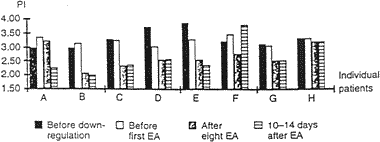
| lndividual patients | |||||||||
| Pl value | A | B | C | D | E | F | G | H | Mean Value |
| Before down-regulation | 3.00 | 3.00 | 3.30 | 3.75 | 3.90 | 3.25 | 3.14 | 3.33 | 3.34 |
| Before EA | 3.38 | 3.15 | 3.27 | 3.04 | 3.30 | 3.50 | 3.10 | 3.34 | 3.26 |
| After eight EA | 3.24 | 2.07 | 2.37 | 2.57 | 2.59 | 2.80 | 2.54 | 3.34 | 2.68 |
| 10-14 days after eight EA | 2.25 | 2.01 | 2.40 | 2.60 | 2.40 | 3.84 | 2.54 | 3.20 | 2.65 |
The right and left uterine arteries responded similarly to EA. The diffcrence in mean PI between the two arteries was ≤0.3 (not significant), both before down-regulation, during down-regulation and throughout the whole study period. There was no significant difference in the mean PI for patients with different causes of infertility.
Skin temperature The pooled results from all skin temperature measurements are presented in Figure 3. Compared with the starting point, mean STFH increased significantly after 21 min of EA (P = 0.02), and directly after the EA treatments (P = 0.002). STLS did not change significantly.
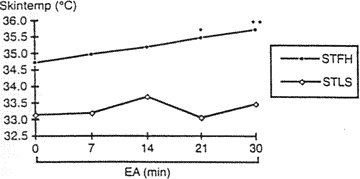
Discussion It has been shown in previous studies that a high PI in the uterine arteries is associated with a decreased pregnancy rate following IVF-embryo transfer (Goswamy et al., 1988; Sterzik et al., 1989; Steer et al., 1992, 1995a.b; Coulam et al., 1995). The results reported by Tekay et al. (1995) support the hypothesis postulated by Steer et al. (1992) that uterine receptivity is improved when the PI value is between 2.0 and 2.99 on the day of embryo transfer. When a high PI is found before embryo transfer in a stimulated cycle, treatment options are few. Goswamy et al. (1988) successfully tried pre-treatment with exogenous oestrogens in the next cycle, but their results have not been verified by others. It has been proposed that the embryos should be frozen, thawed and transferred in an unstimulated cycle (Goswamy et al., 1988; Steer et al., 1992, 1994), but there is little support for the hypothesis that the PI would be lower under these contitions. In experiments on spontaneously hypertensive rats, EA at low frequency (2-3 Hz) induced a long-lasting, significant fall in blood pressure which was associated with decreased activity in sympathetic fibres (Yao et al., 1982; Hoffman and Thoren, 1986; Hoffman et al., 1987, 1990a,b). A decrease in sympathetic activity appears to be generalized. In microneurographic studies on humans, EA in the upper limbs resulted in an initial increase and then a decrease in activity of sympathetic efferents in the tibial nerve, with a parallel increase in the temperature of the skin (Moriyama, 1987). Kaada (1982) reported that transcutaneous stimulation of acupuncture points in the hand increased the skin temperature, giving pain relief in limbs suffering from Reynaud’s phenomenon. Kaada (1982) also found that electrical stimulation of accupuncture hand points in patients with ischaemic conditions of the lower limbs, increased the skin temperature in the lower limbs and possibly enhanced the healing of long-standing ulcers. It has been noted in both animals and humms that EA has greater effects on pathological conditions, e.g. hypertension or hypotension, whereas normal blood pressure is only slightly changed (Yao et al., 1982: Hoffman and Thoren, 1986: Hoffman et al., 1987, 1990a,b). The mechanisms of sympathetic inhibition following EA are poorly understood. Based on animal experiments, Hoffmann and Thoren (1986) and Hoffman et al. (1987, 1990a,b) suggested that electrical slimulation of muscle efferents innervating ergoreceptors increases the eoncentration of ß-endorphin in the CSF. They found support for the hypothesis that the hypothalamic ß-endorphinergic system has inhibitory effects on the vasomotor centre, and thereby a central inhibition of sympathetic activity. It has been suggested that this central mechanism, involving hypothalamic and brain stem systems, is important in changing the descending control of many different organ systems, including the vasomotor system (Andersson. 1993; Andersson and Lundeberg, 1995). In this study, the PI of the uterine arteries was signifieantly decreased soon after the eighth EA treatment and remained significantly decreased 10-14 days after the EA period. These findings suggest that a series of EA treatments increases the uterine artery blood flow. Another effect observed in this study was the signifieantly inereased STFH during the EA treatments. The most likely cause of these effects is a decreased tonic activity in the sympathetic vasoconstrictor fibres to the uterus and an involvement of the central mechanisms with general inhibition of the sympathetic outflow, in accordance with previously observed EA effects (Kaada. 1982; Yao et al., 1982; Cao et al., 1983: Hoffman and Thoren, 1986; Hoffman et al., 1987, 1990a,b; Moriyama, 1987; Reid and Rubin, 1987; Jansen et al., 1989). In conclusion. the present study showed a decrease of the PI in the uterine arteries following EA treatment. Randomized studies on a greater number of patients are needed to verify these results and to exclude non-specific effects.
References Andersson, S.A. (1993) The functional background in acupuncture effects. Scand J. Rehab, Med. Suppl., 29. 31-60. Andersson, S.A. and Lundeberg. T. (1995) Acupuncture – from empiricism to science: functional background to acupuncture effects in pain and disease. Med. Hypoth., 45, 271-281. Bonica, J. (1990) The Management of Pain, vol. 1, 2nd edn, revised. Lea & Febiger, Philadelphia, London, 156 pp. Cao, :X.D., Xu. S.F. and Lu. W.X. (1983) Inhibition of sympathetic nervous system by acupuncture. Acupuncturc Electro-Ther. Res. Int. J., 8, 25-35. Chen, B.Y. and Jin. Y. (1991) Relationship between blood radioimmunoreactive beta-endorphin and hand skin temperature during the electro-acupuncture induction of ovulation. Acupuncture Electro-Ther. Res. Int. J., 16, 1-5. Coulam, C.B., Stem. IJ.. Soenksen D.M., Britten, S. and Bustillo, M. (1995) Companson of pulsatility indices on the day of oocyte retrieval and embryo transfer. Hum. Reprod., 10, 82-84. Goswamy, R.K. and Steptoe, P.C. (1988) Doppler ultrasound studies of the uterine atery in spontaneous ovarian cycles. Hum. Reprod., 3, 721-726. Goswamy, R.K., Williams, G. and Steptoe, P.C. (1988) Decreased uterine pertusion – cause of infentlity. Hum. Reprod., 3, 955-959. Gerhard, I. and Posteck, F. (1992) Auricular acupuncture in the treatment of female infertility. Gynecol, Endocinol., 6, 171-181. Hoffmann, P. and Thoren, P. (1986) Long-lasting cardiovascular depression induced by acupuncture-like stimulation of the sciatic nerve in unanaesthetized rats. Effects of arousal and type of hypertension. Acta Physiol., Scand., 127, 119-112. Hoffman, P., Friberge, P., Ely, D. and Thoren, P. (1987) Effect of spontaneous running on blood pressure, heart rate and cardiac dimension in developing and established spontaneous hypertension in rats. Acta Physiol., Scand., 129, 535-542. Hoffman, P., Skarphedinsson, J.O., Delle, M. and Thoren, P. (1990a) Electrical stimulation of the gastrocnemius muscle in spontaneously hypertensive rat increases the pain threshold: role of different serotonergic receptors. Acta Physiol., Scand., 138, 125-131. Hoffman, P., Terenius, L. and Thoren, P. (1990b) Cerebrospinal fluid immunoreactive beta-endorphin concentration is increased by long-lasting voluntary exercise in the spontaneously hypertensive rat. Regul. Pept., 28, 233-239. Jansen, G., Lundeberg, T., Kjartansson, J. and Samuelsson, U.E. (1989) Acupuncture and sensory neuropeptides increase cutaneous blood flow in rats. Neurosci. Lett., 97, 305-309. Kaada, B. (1982) Vosodilatation induced by transcutaneous nerve stimulation in peripheral ischemia (Raynaud’s phenomenon and diabetic polyneuropathy), Eur. Heart J., 3, 303-314. Moriyama, T. (1987) Microneurographic analysis of the effects of acupuncture stimulation on sympathetic muscle nerve activity in humans: excitation followed by inhibition. Nippon Seirigaku Zasshi., 49, 711-721. Reid, J.L. and Rubin, P.C. (1987) Peptides and central neural regulation of circulation. Physiol. Rev., 67, 725-749. Steer, C.V., Campbell, S., Pampiglione. J.S. et al. (1990) Transvaginal colour flow imaging of uterine arteries during the ovarian and menstrual cycles. Hum. Reprod., 5, 391-395. Steer. C.V., Campbell, S., Tan, S.L. et al. (1992) The use of transvaginal colour flow imaging after in vitro fertilization to identify optimum uterine conditions before embryo transfer. Fertil. Steril., 57, 372-376. Steer, C.V., Tan. S.L., Mason, B.A. and Campbell, S. (1994) Midluteal-phase vaginal color Doppler assessment of uterine artery impedance in a subfertile population. Fertil. Steril., 61, 53-58. Steer, C.V., Williams, J., Zaidi, J., Campbell, S. and Tan, S.L. (1995a) Intra-observer, interobserver, interultrasound transducer and intercycle variation in colour Doppler assessment of uterine artery impedance. Hum. Reprod., 10, 479-481. Steer, C.V., Tan, S.L., Mason, B.A. and Campbell, S. (1995b) Vaginal color Doppler assessment of uterine artery impedance correlates with immunohistochemical markers of endometrial receptivity required for the implantation of an embryo. Fertil., Steril., 61, 101-108. Sterzik, K., Hütter, W., Grab, D. et al. (1989) Doppler sonographic findings and their correlation with implantation in an in vitro fertilizalion program. Fertil. Steril., 52, 825-828. Tekay, A., Martikainen, H. and Jouppila, P. (1995) Blood flow changes in uterine and ovorian vasculature, and predictive value of transvaginal pulsed colour Doppler ultrasonography in an in-vitro fertilization programme. Hum. Reprod., 10, 688-693. Yao. T., Andersson, S. and Thoren, P. (1982) Long-lasting cardiovascular depressor response following sciatic stimulation in SHR. Evidence for the involvement of central endorphin and serotonin systems. Brain Res., 244, 295-303. Zaidi, J., Jurkovic. D., Campbell, S. et al. (1995) Description of circadian rhythm in artery blood flow during the peri-ovulatory period. Hum. Reprod., 10, 1642-l646.
